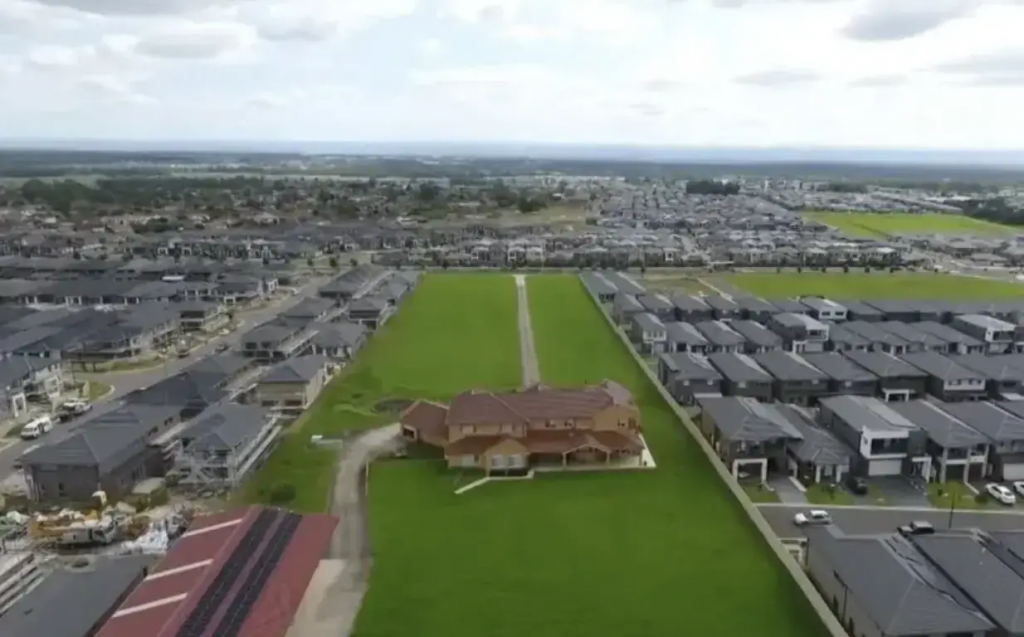A family in The Ponds, a rapidly developing suburb near Quakers Hill, Australia, has captivated public attention by steadfastly refusing to sell their beloved dream home, despite receiving increasingly lucrative offers from eager property developers. In an era where urbanization and real estate speculation are at an all-time high, the Zammit family’s unwavering commitment to their home stands as a remarkable testament to the power of sentimental value over monetary gain. Their story is not just about property; it is about preserving memories, honoring heritage, and standing firm against the tides of modernization.

The Zammit family’s property is nothing short of extraordinary. Sprawled over five acres, the residence is characterized by Windsor Castle-style architecture and boasts a majestic 650-foot driveway that winds through its expansive, lush green lawn. Located just 40 minutes away from Sydney’s bustling central business district, the property offers breathtaking panoramic views of the iconic Blue Mountains. This picturesque setting, coupled with the home’s timeless elegance and historical charm, explains why the Zammits remain deeply attached to their abode, despite the staggering offers that have come their way.
Back in 2012, the property was valued at an impressive $4.75 million. But with the rapid urban development encroaching upon the once-spacious neighborhood, its worth has skyrocketed. Developers see the land as a goldmine, with its prime location and generous acreage presenting the potential for significant financial returns. In fact, local real estate expert Taylor Bredin from Ray White Quakers Hill estimates that the land could accommodate up to 50 houses, with each subdivided 3,200-square-foot block potentially fetching a million dollars. This means the property’s overall value could easily exceed $50 million—a tenfold increase in just over a decade.

Despite these jaw-dropping figures, the Zammit family remains resolute. Most recently, they turned down a $50 million offer, leaving many to wonder what drives their unwavering decision to stay. For the Zammits, the answer is simple: their home is irreplaceable. It is not just about bricks and mortar but about memories, love, and a way of life they are not willing to give up. The family’s attachment to their home is deeply rooted in nostalgia and a strong sense of identity. They are determined to protect the sanctuary they have built, refusing to let the allure of wealth compromise their values.
Their decision to stay put has inspired widespread admiration and sparked conversations on social media. One user commented, “Poor guys. They just want to live in peace,” reflecting the empathetic sentiment shared by many. Another added, “If the house has a lot of sentimental value to the owners, I can totally agree with their decision.” Some viewers applauded the family’s courage, with remarks such as, “Good for them,” and “Apparently money can’t buy everything, after all.” These comments highlight the deep respect people have for the Zammits’ decision, viewing it as a rare example of integrity in an increasingly commercialized world.

Taylor Bredin, who has witnessed the transformation of the neighborhood firsthand, commends the Zammit family’s stance, saying, “The fact that most people sold out years and years ago, these guys have held on. All credit to them.” His admiration speaks to the rarity of such resilience, especially in an area that has undergone drastic changes. A decade ago, the surrounding landscape was dotted with little red brick homes and cottages, surrounded by vast open spaces and lush farmlands. Today, the property stands isolated amidst a sea of high-density houses that press against its fence line, creating a stark contrast between old-world charm and modern urban sprawl.
Australian buyers agent Ella Cas weighed in on the situation, emphasizing the financial potential of the land. “Land does 80 percent of the heavy lifting when it comes to capital growth,” she explained, pointing out the substantial investment opportunity that the Zammits are forgoing. She further shared anecdotes of farmers who bought land for pennies and are now millionaires, highlighting the property’s untapped financial potential. Yet, for the Zammits, no amount of money seems to be enough to make them part with their cherished home.

Diane Zammit, one of the family members, offered a heartfelt perspective on their decision. In an interview with 7News, she reminisced about the neighborhood’s past, painting a vivid picture of a time when the area was a serene haven, far removed from the hustle and bustle of modern city life. “It was farmland dotted with little red brick homes and cottages,” she recalled wistfully. “Every home was unique, and there was so much space—but not anymore. It’s just not the same.” Her words capture the emotional loss that comes with urbanization, a sentiment shared by many who witness their hometowns transform beyond recognition.

A timelapse video circulating on social media illustrates the dramatic changes around the Zammit property. The footage shows years of construction rapidly closing in on the once-secluded estate, yet the house remains a steadfast anchor amidst the relentless urban expansion. This powerful imagery symbolizes the family’s determination to preserve their legacy, even as the world around them continues to evolve.
The Zammits’ story resonates on a deeply emotional level, reminding people that home is more than just a place—it is a feeling. It represents security, belonging, and a connection to one’s roots. In an age where development often trumps tradition, their refusal to sell is a bold statement of defiance, challenging society’s obsession with material wealth and progress. Their story serves as an inspiring reminder that some things are truly priceless.